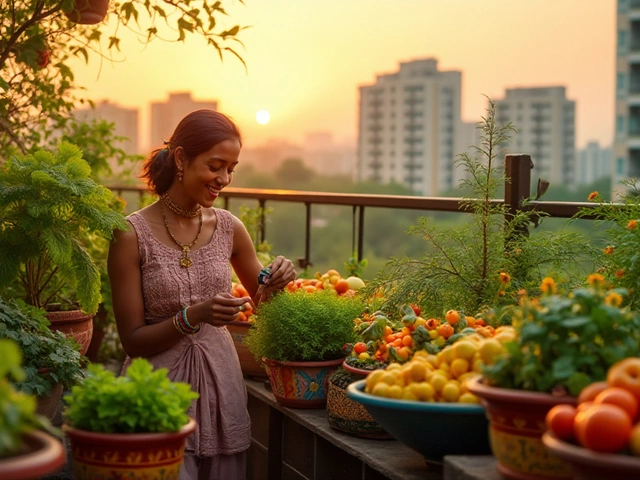So you saw a photo of a glossy, giant lotus blossom floating effortlessly on someone’s backyard pond, and now you can’t stop dreaming of raising your very own at home? Hard to blame you. Lotus flowers don’t just look magical—they carry thousands of years of history, and growing one can feel like inviting a little enchantment into your living space. But before you rush to buy a tuber or seeds, you might be wondering if it’s actually safe or even practical to grow lotus at home. Most people don’t want to mess around with weird pests or have to explain to their landlord why their living room is suddenly a swamp. The safety and practicality questions have some surprising answers, and it helps if you know not just the basics, but what to expect once your container turns into a mini-ecosystem.
What Makes Lotus a Unique Home Plant?
First, let’s talk about why the lotus is so different from typical houseplants. The sacred lotus (Nelumbo nucifera) hails from Asia and certain parts of Australia, often showing up in ponds and lakes, sometimes even in ditches and lowlands. What makes lotus special isn’t just the way it looks or its legendary symbolism in Buddhism and Hinduism. The plant is almost freakishly resilient. A lotus seed that was 1,300 years old reportedly sprouted in a Chinese lab. The leaves are coated in microscopic wax crystals that make water bead up and roll off, keeping the plant free of grime and helping it self-clean. This trick is so interesting it inspired modern wall paints and water-repelling clothing.
But while it handles neglect better than a goldfish, lotus isn’t at all like the pothos dangling near your kitchen window. For starters, you need a body of water—anything from a big ceramic bowl on a balcony to a homemade garden pond. The plant grows from a tuber, not a seed most times, unless you’re in for a real patience test. Leaves float or poke up, looking almost cartoonish with their waxy, saucer shapes. And, if you’re lucky, you’ll get a bloom that lasts three days—or longer, if your conditions are right.
But here’s the catch: while lotus is easygoing once established, it needs specific care to thrive and not cause unexpected headaches. Part of that is about grow lotus at home safety, especially if you’ve got curious pets, little kids, or limited space.
Is Growing Lotus at Home Actually Safe?
It’s easy to assume that anything with a heritage this ancient and a flower this bright should be safe for any yard or home. But safety isn’t just about toxicity. Don’t worry: lotus isn’t poisonous to people, cats, or dogs. Its tubers and seeds are eaten all over Asia, especially in China and India, with recipes ranging from crispy chips to sticky desserts. If you accidentally nibble a leaf or tuber, you won’t end up sick—though they don’t taste like much raw.
But creating a mini lotus pond or bowl isn’t entirely risk-free. Still water is the main concern. Ponds or water bowls can attract mosquitoes, and stagnant water is a breeding ground for all sorts of critters you’d rather not have multiplying under your nose. If you’ve got small kids, drowning risk—even in surprisingly shallow water—is a real issue. According to the CDC, around 20% of drownings in kids under 5 happen in backyard ponds or containers.
Pets, especially cats, may get interested, so keep bowls or tubs where elephants—er, fluffy pets—can’t knock them over and spill water everywhere. If you’re growing lotus indoors, check that the container is leakproof and not where you walk or put electronics. With kids or pets, a sturdy, deep ceramic or wooden bowl with no sharp edges is your best bet. When placed outside, cluster any lotus planters together and consider floating mosquito dunks (BTI-based, non-toxic option) to keep larvae out.
Also, lotus grows fast. Tubers can sneak over the edge of a small pond and root somewhere else if let outside. If your climate is warm and you plant your lotus directly in the ground, expect it to spread as aggressively as bamboo or mint. Stick to contained pots unless you want constant garden management. There’s also minor risk of allergy—lotus pollen can irritate the nose if you bring a patch indoors and it blooms aggressively.
How to Grow Lotus at Home: The Basics and the Surprises
Okay, if you’re still on board, growing lotus at home starts with either seeds (better for patient folks) or tubers (faster results). Tubers are weird: they look like potato sausages with knobs. Each knob grows either a shoot or roots. You bury the tuber horizontally in at least six inches of heavy clay soil in a watertight container—avoid peat, potting mix, and sand. Top with a couple inches of pea gravel to anchor it, then add enough water to cover the gravel by two to six inches. Place the container in full sunlight—lotus loves heat, so go for at least six hours of sun if you hope to see flowers.
- Get a wide (not tall), watertight pot – minimum 15-18 inches across for healthy lotus growth.
- Use topsoil that’s free from fertilizers and chemicals; potting soil floats and gets messy.
- Anchoring the tuber gently is key: press it just into the soil, not under it, or it can rot.
- Refill evaporated water with dechlorinated tap or filtered water, especially in summer.
Lotus is surprisingly hungry: it needs monthly feeding with aquatic plant fertilizer tablets—never sprinkle fertilizer on the water, as it can burn the tuber or encourage algae.
If you start from seeds, you’ll need to scarify (nick) the hard outer shell, then soak them in warm water, changing water daily. Sprouts appear in a week, but don’t let them sit too long—they’ll rot if not planted soon. Tubers tend to flower the first year (with luck), but seedlings take two years—or more—for blooms. If you start indoors, move lotus outdoors when the risk of frost is gone.
Now, here’s the twist: once your lotus leaf unfurls, prepare for visiting critters. Dragonflies love lotus, which is great if you want fewer mosquitoes in your garden, but frogs, snails, and even the odd bird may stop by to investigate. And lotus attracts aphids and sometimes leaf miners if you live in a humid zone. Treat with a sharp jet of water or insecticidal soap—just don’t use anything toxic if you have pets or plan to eat any part of the lotus later.

Benefits of Growing Lotus at Home
Beyond the obvious beauty, there’s a lot to love about home-grown lotus. For one, it’s practically a whole ecosystem in a pot. The leaves repel dirt and purify their water (somewhat), and even in a small tub, you’ll see bees and butterflies stop by. Lotus also absorbs certain toxins from water, helping keep pond water clearer—different studies have shown lotus roots can reduce lead and heavy metals, though you shouldn’t use lotus as your only filtration method.
The mental benefits are real. Caring for lotus is oddly meditative—you spend more time observing leaves unfold and less worrying about wilting. If you’re into edible landscaping, lotus is a winner: every part is edible. The roots (rhizomes) are crunchy, slightly sweet, and full of fiber, potassium, vitamin C, and B6. The seeds (sometimes called lotus nuts) are popular in desserts and sold roasted as a snack. In Japan and China, the leaves are used to wrap sticky rice for steaming, infusing a subtle floral aroma.
Table: Lotus Nutrition Facts (per 100g raw rhizome)
| Nutrient | Amount |
|---|---|
| Calories | 74 kcal |
| Carbohydrates | 17 g |
| Fiber | 4.9 g |
| Potassium | 556 mg |
| Vitamin C | 44 mg |
| Protein | 2.6 g |
Lotus flowers can be snipped and floated in water indoors for an instant, natural air freshener. Plus, studies out of India and South Korea have looked into lotus extracts as natural anti-inflammatory agents. It’s hard not to feel good about growing a flower that won’t just sit there, but can add value to your kitchen or medicine cabinet.
Lastly, lotus is less maintenance than it seems, once you nail down the setup. Unlike most water plants, it outcompetes algae once mature—so your mini pond stays cleaner. There’s a reason Buddhist monks grew lotus for centuries: it’s not just pretty, it’s a plant you can “watch grow” without feeling doomed to fail.
Common Problems and How to Handle Them
Of course, no plant is totally carefree, not even the famous lotus. The first big issue: water evaporation. Indoors, heated homes dry out water bowls fast, and outdoors, you’ll lose even more to summer sun. If your lotus sits dry for a day, young tubers can die. Keep an eye, top up water if needed, and use rainwater if your tap water is very hard.
Algae blooms can be ugly. New lotus pots often turn green and cloudy the first month—don’t panic. As your plant matures, giant leaves shade the water and starve out green scum. Never add goldfish to lotus pots; they’ll eat tender shoots and dig up the tuber. If you want critters, try tiny snails or copepods—both keep debris down and don’t eat live plants.
Aphids are the most annoying pest. They cluster on leaf undersides or flower buds. Wipe them off with a soft sponge or spray with a jet of water. If needed, add a pinch of diatomaceous earth on leaves, but avoid synthetic pesticides entirely. Healthy lotus tolerates mild infestations and bounces back quickly.
Root rot and fungus attack mostly when soil is too wet and air is cool. Make sure you use heavy clay or garden topsoil, never peat. If you notice mushy, stinking tubers, gently remove them and discard. Only replant healthy, firm tubers.
Lastly, lotus can get “stuck” with closed buds not opening. Most common cause: not enough sunlight or over-fertilizing. Move the pot to a sunnier spot or cut back on feeding tablets until the next season.
Tips for Growing Lotus Successfully and Safely at Home
Ready to start your own little water paradise? Here’s the quick cheat sheet for safe, happy lotus growing:
- Pick the right size container—a 5-gallon or larger bowl is ideal; larger for big varieties.
- Use only unpolluted topsoil—never compost or peat moss. Secure the tuber on top, not buried deep.
- Place pots where kids and pets can’t tip them, and beware shallow water risks for toddlers.
- Keep pots in full sun—at least six hours daily—or supplement with a strong grow light indoors.
- Start with tubers for fast results. Seeds are fun, but flowering takes patience.
- Use aquatic fertilizer tablets once a month through growing season; skip it in winter dormancy.
- Control mosquitoes with safe dunks, or introduce mosquito-eating fish/copepods in outdoor setups.
- Clean and sterilize containers every year before replanting to avoid disease buildup.
- Watch for fast-spreading roots—only plant directly in ground where it can’t escape into wild waterways.
- Harvest tubers, leaves, or flowers for food only if free of chemicals and city pollutants.
It’s not hard to watch a patio bowl go from plain dirt and water to lush, green saucers and, finally, a dreamy lotus flower opening each morning. If you give it the right setup and a spot in the sun, lotus can turn an ordinary corner of your home into something a little wild, a little peaceful—and, yes, absolutely safe if you use good sense.





